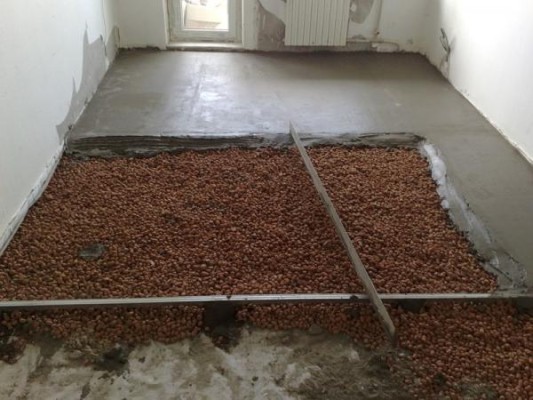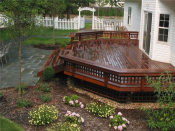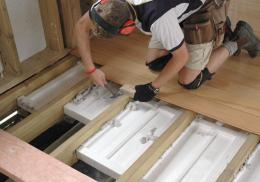Search
Login
Recommended
How to effectively insulate the floors of a bath or sauna. High-quality thermal insulation of a wooden or concrete floor is achieved by the selection of an effective insulation, for example, foam or expanded clay
The urgency of the issue of thermal insulation properties of the floor in the bath is usually associated with the growing popularity of traditional Russian steam rooms, which necessitates the creation of comfortable conditions in the bath. Moreover, the impact of natural and physical factors has a negative effect on the materials used to construct the floor. You will learn more about these factors, as well as how to insulate the floor in the bath, by choosing the optimal insulation, having familiarized yourself with the materials of this article.
Content
- The need for floor insulation in the bath video
- Warming of the wooden floor in the bath. The choice of insulation. Penopleks - optimal insulation
- The sequence of work when warming the floor with foam
- Insulation of the concrete floor in the bath. Expanded clay - the best choice
- Recommendations for floor insulation with expanded clay video
- Penoplex for concrete floor
The need for floor insulation in the bath
Constant humidity and high temperature indicators, when combined, have a detrimental effect on all bath structures, including the floor, which contributes to a high risk of the spread of mold, various fungi and other microorganisms, which contributes to the violation of the climate balance of the room. In addition, the cold floor in the bath will create an unpleasant impression of the bath procedures and can even lead to their abandonment.

The process of lowering the heat consumption of the floor directly depends on its design solution. And in this case several options are possible: in the first case it is a wooden floor, and in the second it is concrete.
Warming of the wooden floor in the bath. The choice of insulation. Penoplex is an optimal insulation.
It is known that many people when installing flooring in a bathhouse or sauna prefer wood as the most environmentally friendly material, which retains good heat with proper thermal insulation, which indicates the need to insulate the floor in the bathhouse. It is customary to make a wooden floor from larch, pine or fir, as they are more resistant to high humidity, which also determines the careful choice of insulation.
Given the increased level of humidity in the bath, when choosing heat-insulating materials, it is advisable to give preference to materials with a closed cellular structure, which include foams.

The most modern representative of foams is foam, which, in fact, is polystyrene foam with a foam structure and a low level of thermal conductivity.

As a heat-insulating material, penoplex meets all the requirements for heaters, the main of which are strength, fire resistance, resistance to excessive moisture, low thermal conductivity and environmental safety. Experts advise using penoplex as a heater precisely in wooden structures, since it has refractoriness and also prevents the formation of fungal microorganisms.

Penoplex insulation will be appropriate for the installation of various wooden configurations and structural solutions. It is preferable to produce it at the stage of construction work, in order to avoid dismantling the entire structure.
The sequence of work when warming the floor with foam
Do-it-yourself penoplex insulation is carried out in several successive stages:
1. Dismantling works with wooden finishing materials, if insulation was not carried out at the construction stage.
2. Strengthening in the lower parts of the beams of overlapping cranial beams, followed by laying a vapor barrier.
3. Strengthening rough boards.
4. Filling the space between the beam ceilings with insulating material.

Insulation of the concrete floor in the bath. Expanded clay - the best choice
If you plan to insulate a concrete floor in a bathhouse, then you must understand the structure of the concrete floor. It involves the pouring of the foundation, on which concrete floor slabs are laid, with the subsequent arrangement of a third, waterproofing layer. Next, heat-insulating material is laid and a screed with a reinforcing mesh is arranged. When arranging a concrete floor, it is possible to insulate with various materials, the spectrum of characteristics of which is also extremely diverse.

But experts advise thermal insulation expanded clay, and this is no coincidence.
Expanded clay is characterized by a wide distribution at construction sites, due to the presence of certain operational characteristics. In its structure, it is a lightweight heat-insulating material with a porous structure, which is produced by burning clay or shale.

The advantages of the material that are used in arranging thermal insulation are achieved due to the presence of porous granules that provide the necessary level of performance characteristics that have found their application in the construction industry.
The main ones include:
1.Manufacture from an absolutely environmentally friendly material, which is characterized by the absence of any harmful impurities.

2. Due to the presence of a porous structure, expanded clay has a high level of heat and sound insulation characteristics.

3. The flowability of expanded clay, achieved due to the fine granules of the material, allows you to fill all available voids.
4. Resistance to temperature changes, and fluctuations in the level of humidity makes it possible to use expanded clay in various climatic zones, as well as rooms for various purposes.

5. The lightness of the material significantly reduces labor costs and improves the efficiency of the work.
Recommendations for floor insulation with expanded clay
There are a number of recommendations that it is desirable to observe when warming the floor with expanded clay.
Firstly, in order to achieve a higher level of thermal insulation, it is recommended to abandon mixing expanded clay with concrete, and confine it to only filling it in layers, the level of which should be at least 10 cm.

Secondly, before arranging the screed and layer-by-layer filling of expanded clay, it is necessary to calculate the level of load acting on the floor.
Thirdly, in order to provide the greatest adhesion force to the expanded clay fraction groups and to exclude any material mobility, it is recommended to use expanded clay granules of various sizes, which will improve the degree of adhesion, and after applying the coating, we must not forget about waterproofing, which will protect the layer of heat-insulating materials from moisture penetration . The role of a high-strength waterproofing can be easily solved by a polyethylene film placed on top of expanded clay.
Fourth, in order to ensure the evenness of the expanded clay layer in the process of arranging the thermal insulation of the concrete floor, it is necessary to take care of installing special beacons that serve to level the screed. For greater efficiency, they are fixed with cement mortar.

And, finally, in order to return to the original density, the insulation layer is shed with cement mortar (cement milk) to ensure the immobility of the material when arranging the concrete screed. It is also possible to reinforce the floor using a metal mesh, which will reduce the risk of deformation and give additional strength to the coating.

The final step when warming a concrete floor is a floor screed with expanded clay. It is achieved by pouring concrete mortar, which is usually started from a wall located on the opposite side to the entrance, while focusing on the level of lighthouses.

After screeding, it is not recommended to use the floor earlier than a week, and throughout the drying period it is necessary to moisten the floor with water at a certain frequency to prevent cracks.
Penoplex for concrete floor
Warming of a concrete floor, as well as a wooden one, can also be done with the help of foam. This is fully justified, since a zero level of water absorption makes the use of foam in the construction of concrete floor insulation optimal. Low water permeability and resistance to biodegradability under the influence of moisture are relevant for the installation of concrete floors, as it conducts moisture well from the environment and soil. Environmental safety, which is characterized by foam, is achieved thanks to the features of technological production, which consists in foaming polystyrene foam with carbon dioxide.






